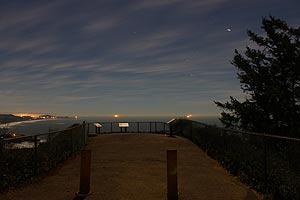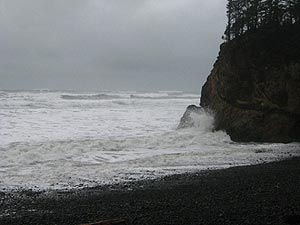 |
Will the Oregon Coast See the Super Full Moon?
Published 03/18/2011

(Manzanita, Oregon) – The short answer is: "Probably periodically." Above: A Super Harvest Full Moon taken in September 2010.
Saturday, March 19 is presenting a “Super Full Moon” as it will appear larger than usual that night – for the last time in 30 years. It will be brighter and bigger, what NASA called of “rare size and beauty.”

Lunar eclipse photo taken from Manzanita in late 2010.
Of course, the ability see this on the Oregon coast or anywhere else in Oregon is dependent on the weather, and that’s the big question for the region. With this full moon, however, comes some extra wonders for the coast as well in the form of tides.
If you know the Oregon coast, then you know weather systems change a lot more drastically and a lot quicker than inland spots like Portland or Eugene – especially in spring. According to The Weather Channel and Rssweather.com, the Oregon coast will be mostly cloudy that night, with some rain and a chance of thunder storms. Considering the coast’s penchant for constant change in the skies, this will likely translate into periods when you can see the moon in its full glory, alternating with times when it’s completely covered over and periods when it’s visible through the clouds.

Nighttime above Manzanita
Apparently, the coast will largely share the same weather, which includes towns like Cannon Beach, Manzanita, Tillamook, Lincoln City, Newport and Yachats. Even Wheeler and Nehalem, which are just inland enough to often get less clouds, will be looking at the same forecast.
"Scattered showers and a slight chance of thunderstorms in the evening,” said Rssweather.com in its forecast. “Then a slight chance of showers after midnight. Lows 35 to 40. Southeast wind 5 to 10 mph. Rainfall amounts less than a tenth of an inch. Except higher amounts possible in thunderstorms."
 |
| Stargazing between Depoe Bay and Newport |
The Super Full Moon is caused by the moon being closer to the Earth than usual, because of its elliptical orbit around the Earth. The part of the orbit that is closest to the Earth is called the perigee – so this is known as a perigee moon, which results in it being about 14 percent bigger and 30 percent brighter.
The apogee is the opposite – when the moon is at its farthest part of the orbit.
High tides will be a little extra high, by as much as six inches. In Florence, high tide happens at 1:06 a.m. with a seven-foot high tide, and again at 1:23 p.m. with 7.1 feet. Low tides will not be as low as normal, which should mean some extra caution for sneakers waves and such on beaches.
 |
| High tides and winter storms expose gravel beds near Cannon Beach |
Such wacky tidal conditions could mean some larger, more dramatic storm-like waves, depending on weather. And after the high tides of this weekend, some erosion could occur which might open up more gravel beds – and thus increase agate hunting possibilities. These higher waves could also cause some interesting goodies to wash up onshore, such as whale burps or ocean burps – odd clusters of sundry sea life.
Astronomers suggest looking at the Super Full Moon when it’s low on the horizon, because there's an optical illusion effect that causes the moon to look even bigger. This mixes with the actual reality of the moon’s increased size, causing some spectacular views.
Moonrise on the north Oregon coast – at least in Astoria – will be at 8:02 p.m. Moonrise in Portland will be at 7:57 p.m.
Video and stills from Super Harvest Moon in September.
More about Stargazing Tips on the Oregon Coast
More About Oregon Coast hotels, lodging.....
More About Oregon Coast Restaurants, Dining.....
 |
 |
 |
LATEST OREGON COAST NEWS STORIES
Washington Coast Cleanup on April 19 - Coinciding with Oregon Coast's SOLVE E... |
Back to Oregon Coast
Contact Advertise on BeachConnection.net
Secrets of the Season |
Unusual Travel Articles TravelParanormal.com allows you to submit your own creepy tale or debunk one - or see up-to-the-minute news headlines about travel and the paranormal. News Headlines from All Over Oregon Need to scan Oregon headlines? Constantly updated news from all over Oregon: a comprehensive, up-to-the-minute display of news headlines from a variety of media |






































